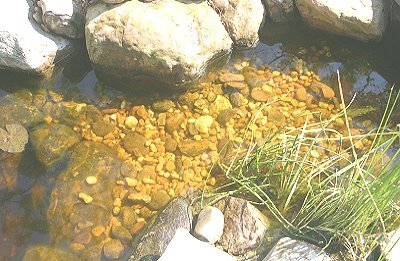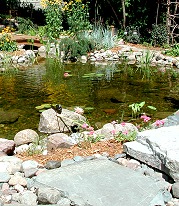
Gravel In Ponds
Understanding Gravel Bottom Ponds
This has been my tenth year with a gravel-bottom pond. And, on top of that it’s my fifth such pond, I had my first one at the lab. It’s the standard smaller installation I got to “see about” these ponds and what they were like. After that experience I decided that my “real” pond would be an enlargement on that technology.
A properly installed gravel bottom pond can be a genuine joy. I don’t like daily or even weekly management of a pond with a dragster filter. I prefer once per year management, and damn right; I farm it out to younger people than me. It’s hard work. Once per year. I never have to check a gauge, pressure valves, replace bulbs, clean filter pads or beads, nothing. It just runs on the balance of fish to plants, gravel, beneficial bacteria (none of which I have to add but which are naturally occurring) and most important of all, replacement of fresh water which is necessary in ANY pond built for Koi.
You might say; “Sure you’d say that, you work for the major installer of those ponds!” and I would say; First, if you really said that; I would say you’re a bastard for insinuating that would cause me to lie. Second, I’d inform you that the company fired me in 2007. Without a financial tether of any kind, as if that was my motivation, or if anyone would retract their comments or be bent, or badmouth the system, it’d be me. Except I can’t, because my gravel-pond totally rules. I love it.
Anyway. People who say rock bottomed ponds are not good enough for koi are ignorant. People who say SOME rock bottomed ponds are not good enough for Koi could have a point depending on variables at play. The way they are maintained, or not maintained, has a lot to do with that. Stocking density and feeding interval and whether the owner was ever EVEN taught about water changes – all factor in.
I never got String Algae in my first few gravel ponds because I had: Tons of plants, and two plecostomus.
My first couple gravel ponds were in the full sun. The water is gin clear. My fish spawned for the first time ever, two years in a row. Something they NEVER did in the liner ponds I loved before (and still like quite a bit now).
I don’t love River Otters though. I hate River Otters.
The fish at Bailey Farm, in 2010, ended up in the stomachs of a family of River Otters. But, for the two years prior, it was a well running enjoyable installation complete with tadpoles, snakes and baby fish.
“Well your gravel pond system was different! It was better installed!” This could be true. But you’d be making my point that, if done right, a gravel bottomed pond can be a joy.
 Once you have a gravel bottomed pond, you see that so many of the bad things people say are not always true, and are usually based on the simple fact that they don’t have a gravel bottom pond. For example – “The gravel traps debris”.
Once you have a gravel bottomed pond, you see that so many of the bad things people say are not always true, and are usually based on the simple fact that they don’t have a gravel bottom pond. For example – “The gravel traps debris”.
First, EVERY filter traps debris. The real question is what happens to that debris, and does it work for the fish?
Well gravel trapping would be a Bad Thing if:
1. The Koi could not root in said gravel.
2. The gravel was deeper than 3-4 inches.
3. We weren’t changing water.
So again you see there are variables. Variables a lot of people don’t even factor in like gravel bed micro-organisms, copepods and nematodes that can contribute MAJORLY to the vitality and turnover in the ecosystem and which Aquascape hasn’t even completely documented! Philodina, a microorganism that depends on live plant material (the rootball to be exact) for it’s livelihood, which is EATING BACTERIA! And finally plant agglutinins, which are soluble proteins from plants that agglutinate suspended debris and settle it out for access by plant roots. All sorts of stuff I learned at University of Georgia a year or two ago. But which is unknown to people who just ‘accept’ that gravel beds are inert.
Believe me when I say I’ve seen some really sucky gravel pond installations. Laughable, horrible jobs. And some really, really amazing good ones.
Let me tell you about some of the dragster systems I have seen sprawling through some peoples back yards and into their basements, with every imaginable light, bulb, gauge and control module – some of them are really sucky technological installations. Laughable, horrible jobs. So extreme you have to consult a manual just to take care of your bud’s fish pond when they go away. And some really really amazing good ones.
This is just an effort to get people to stop believing everything they read about the ‘dire necessity’ of, for example, a “bottom drain” (just ONE example of things taken on rote dogma) I (for one) have NEVER had a cut in, through the liner bottom drain, EVEN when I had dual-bead-filtration-with-ultraviolet sterilizers-and-propane-fired-heating-systems-with-a-hopped-up hydoxyl-transventralism-ion-generator from Sinclair Fuel Extensions. Oh…sorry, back to bottom drains – I think a bottom drain (of the conventional type) is a great way to quickly and completely empty your pond if there’s a plumbing failure. So I’ve avoided em.
But don’t get me wrong, bottom drains are also great!!! …just like my points above – there’s always two ways to look at things and usually two sets of experiences. And it has more to do with your expectations than on the things you’ve been told.
Some people define “perfect water” different ways. I propose that the most important number in the measurement of water quality is the nitrate number because it has a direct correlation to background pollution and dissolved gases which could be considered toxic to fish and their ecosystem. Other people focus on Ammonia and ORP readings. To each his own. Again it goes to expectations.
Don’t be told what to expect. Benefit from other peoples EXPERIENCE but not what some pundit says. Unless they can point the technology in question, in their own back yard. Literally, or figuratively.
RUN AWAY when you read “I don’t know, but I’ve been told” You should also be skeptical when someone uses terms like “Always” and “Never” “Every time”
God bless you and good luck finding the right pond.
Dr Erik Johnson
